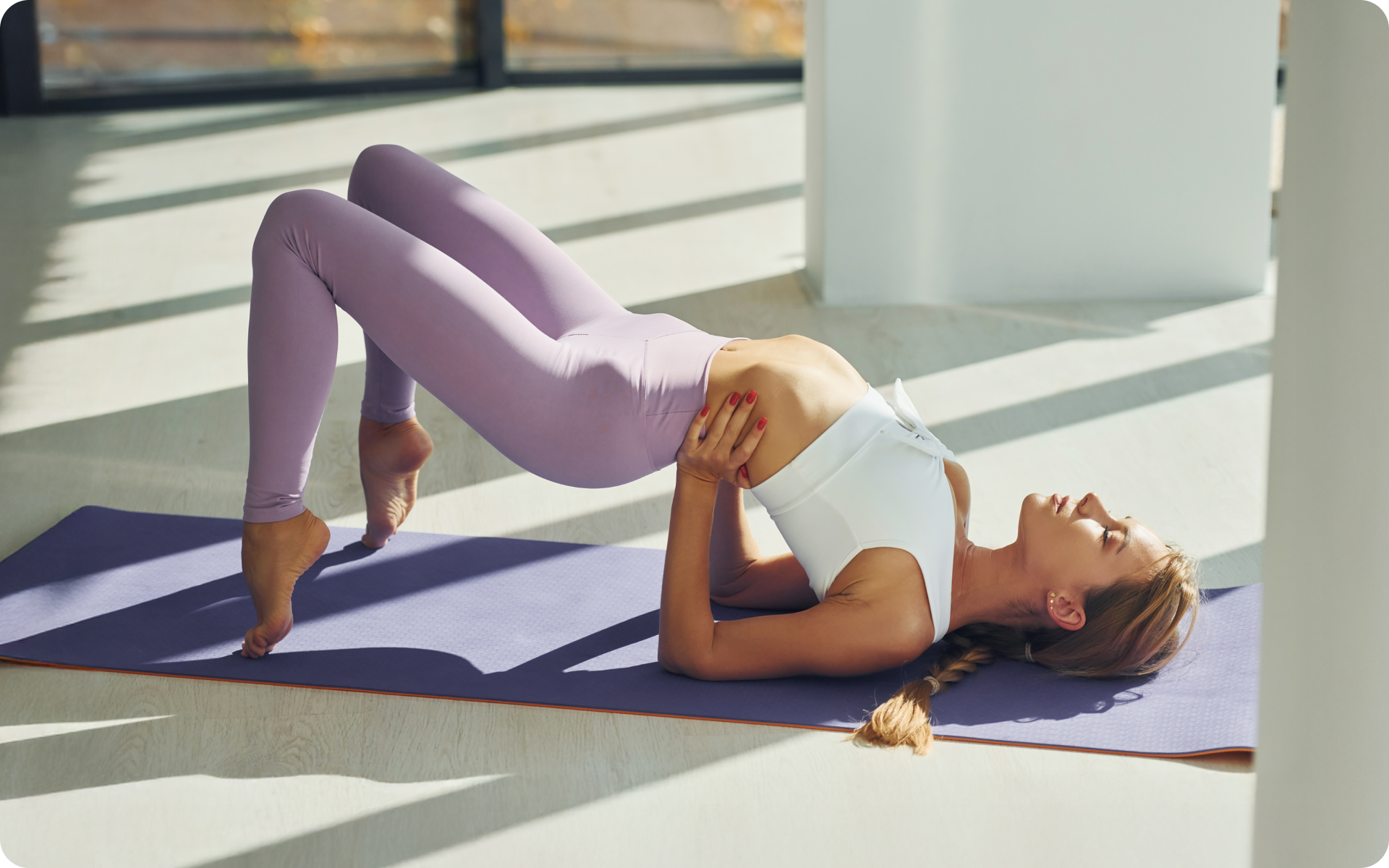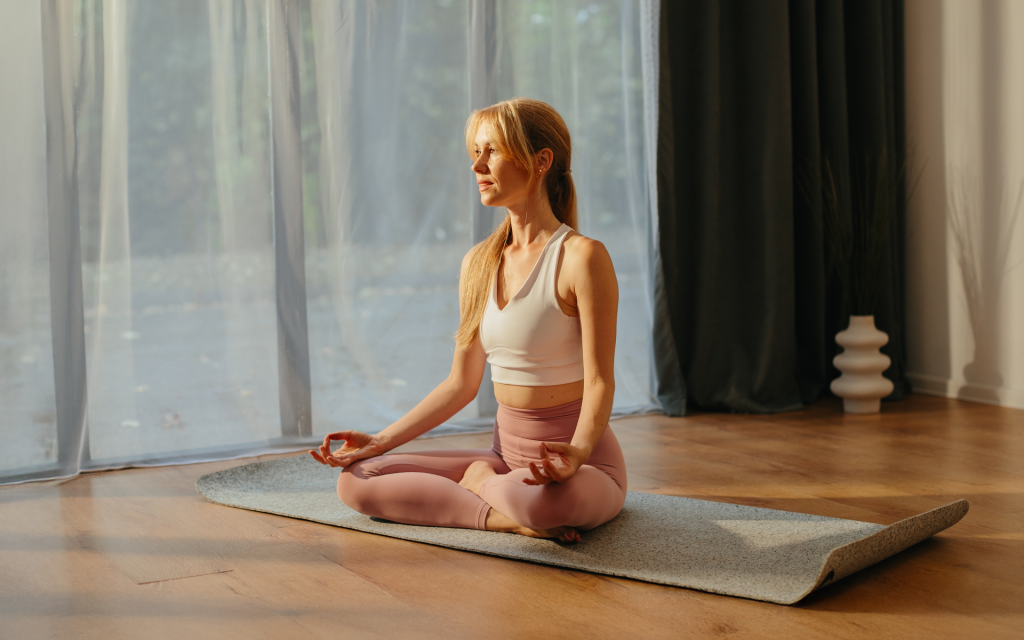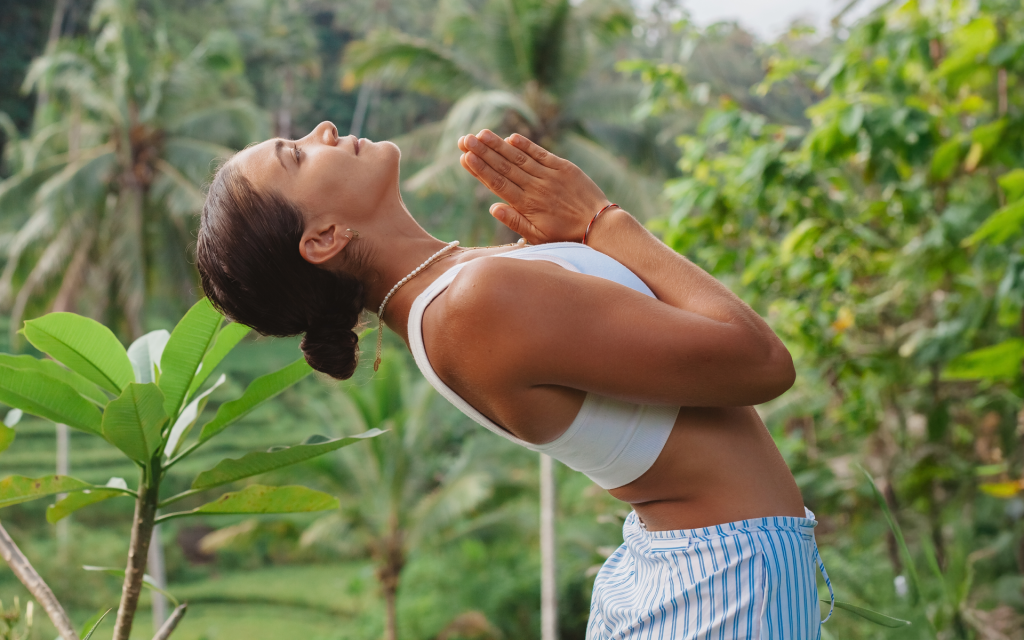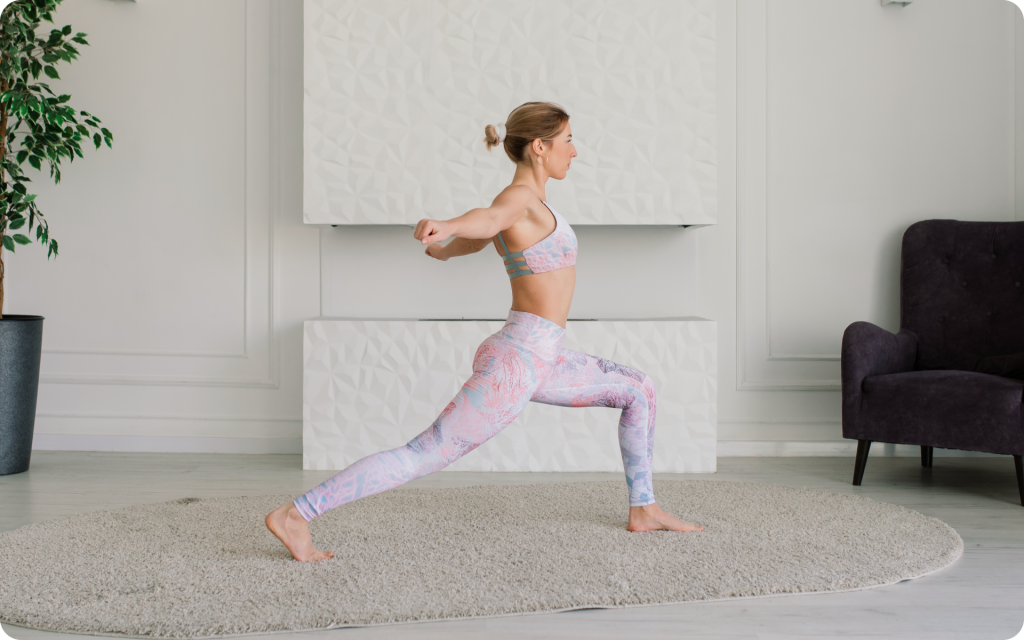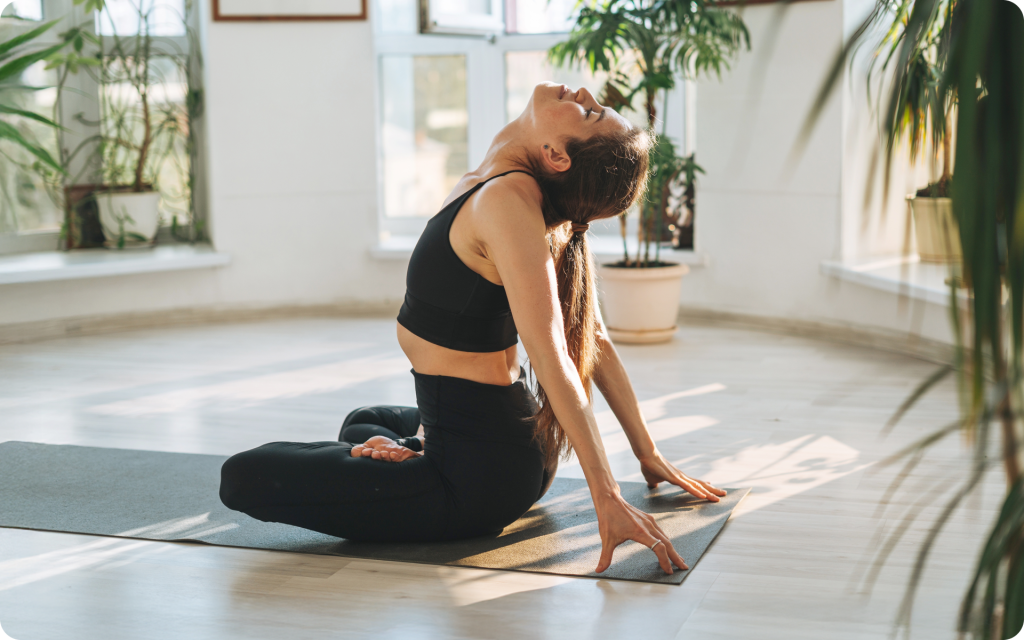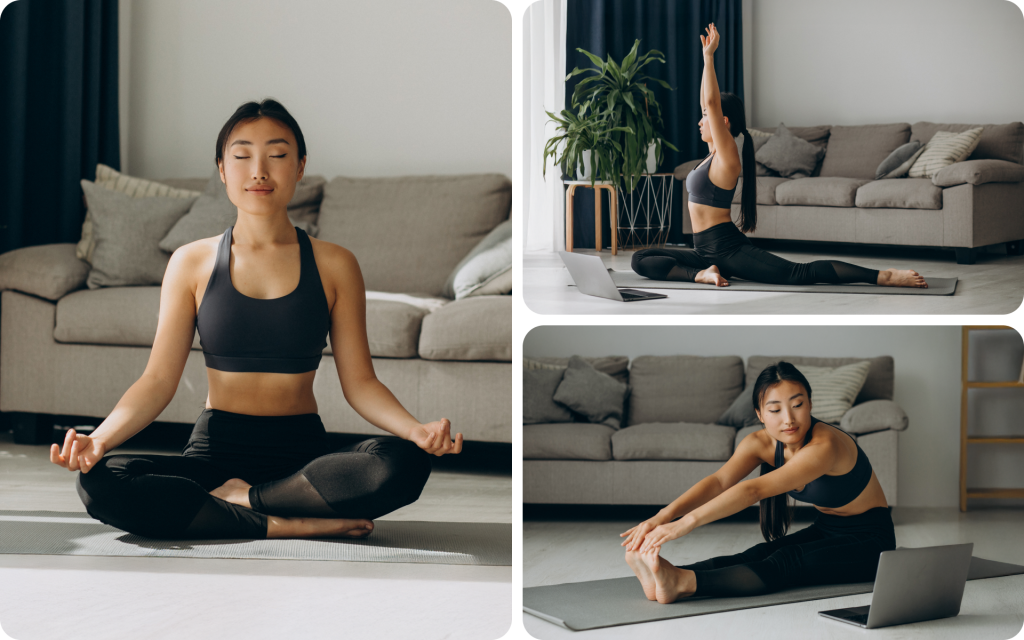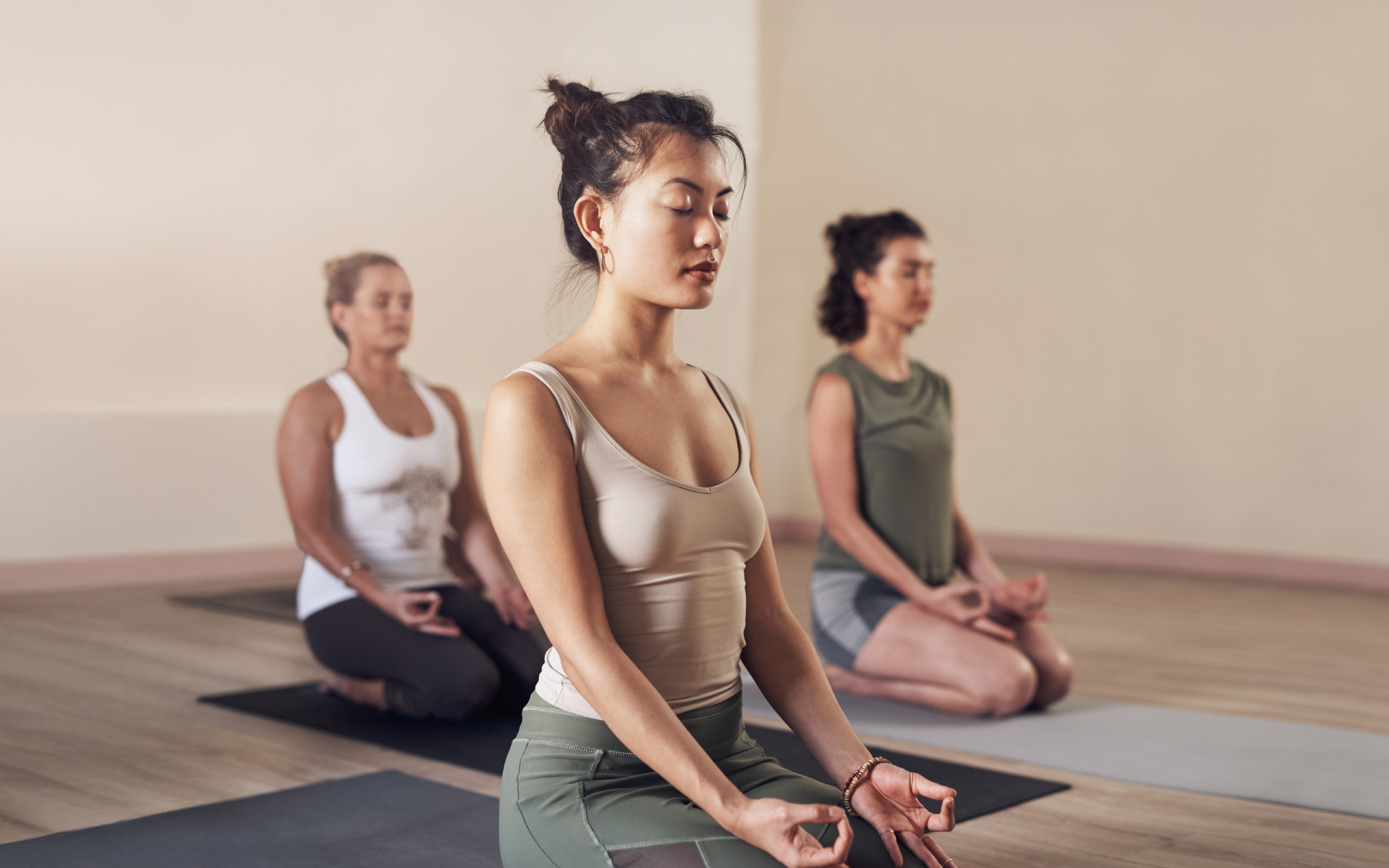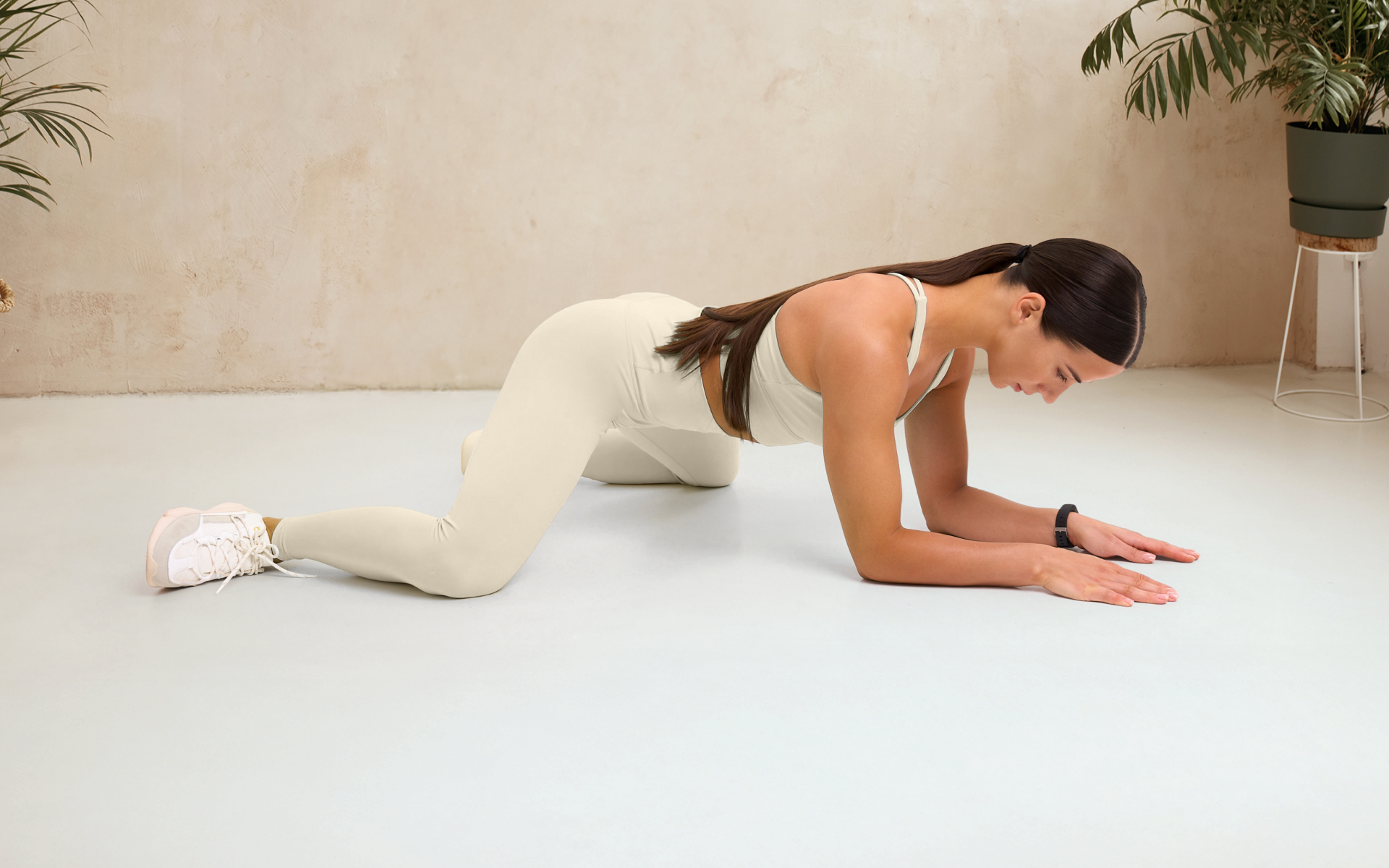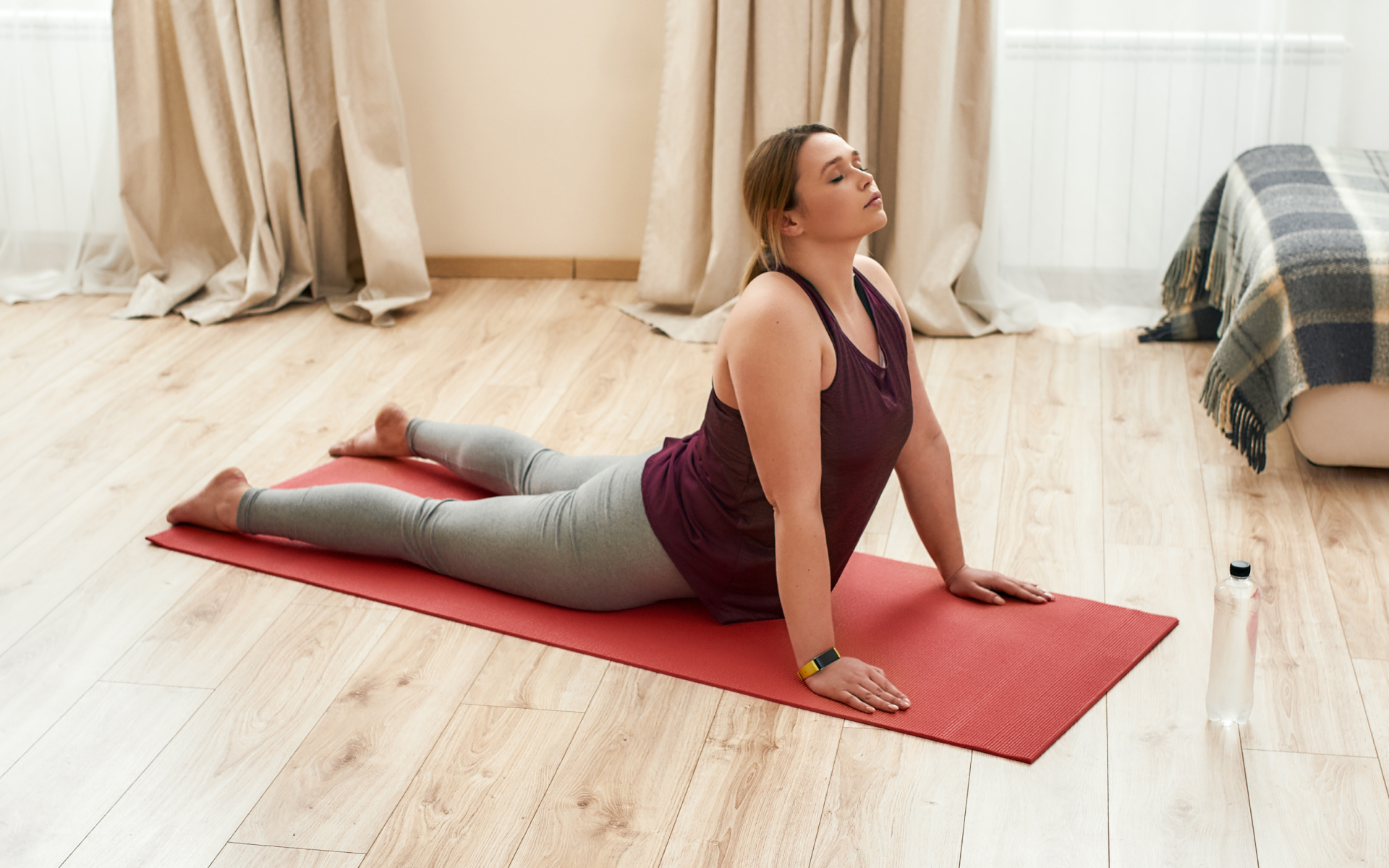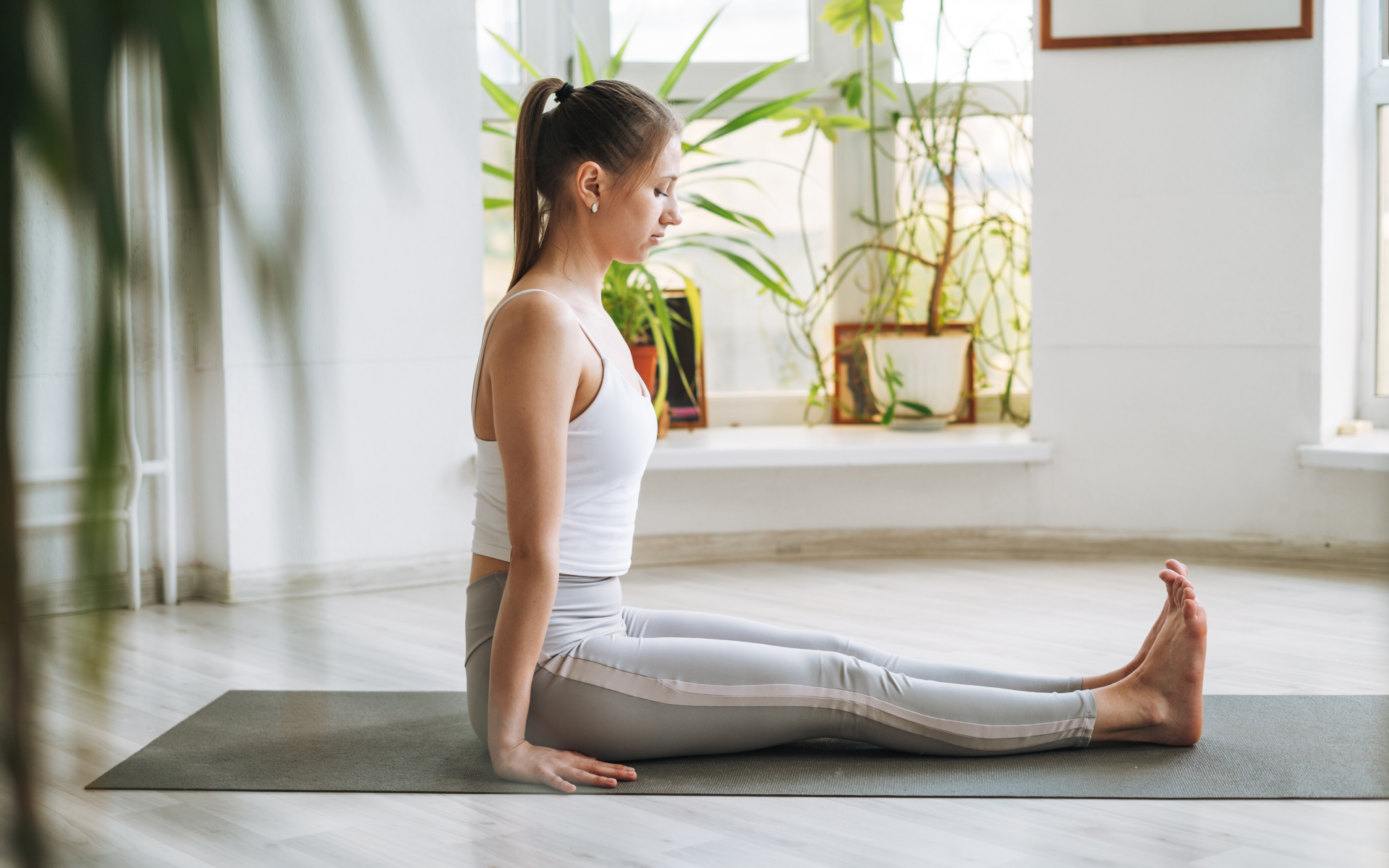If you tend to carry tension in your body or feel constantly stressed throughout the day, adding just a few minutes of somatic stretching may offer a sense of relief.
Somatic stretching exercises combine traditional stretches with somatic principles to help you slow down, tune into your body, and stay present (1, 2). It may sound simple, but this gentle approach can be effective for developing a greater awareness of how your mind and body feel and respond to each other. While it’s not a cure-all, it can be a supportive tool to consider adding to your self-care routine.
This article covers what somatic stretching exercises are, their key benefits, and what you need to know before you start your own somatic stretching practice.
What Is the Purpose of Somatic Stretching Exercises?
Somatic stretching exercises are a form of mindful movement that helps you tune into how your body feels during movement (1, 2). Instead of focusing on flexibility or fitness goals, it focuses on paying attention to internal sensations as you stretch.
By doing this, you may start to recognize patterns of tension or discomfort that often go unnoticed in daily life (3). Over time, this awareness enhances your ability to release stress or tension while you become more relaxed (3, 4). It can also be a simple way to pause and reset whenever you need a moment of rest or a break in your day.
As everyone’s experience is different, it’s always important to consult your healthcare provider before you start any new wellness practice. They can help determine whether somatic stretching is right for your needs and offer personalized advice as required. If you’re curious how often should you stretch, check out our earlier article.
What Makes Somatic Stretching Different from Regular Stretching?
Traditional stretching typically involves deliberately lengthening a specific muscle or muscle group to improve flexibility, strength, and a healthy range of motion in the joints (5). In addition, the benefits of stretching often help maintain muscle elasticity and prevent tightness, which can play a key role in reducing the risk of joint pain, strain, or injury (5).
On the other hand, somatic stretching focuses less on physical performance and more on internal awareness (1). Instead of trying to stretch as far as possible or hold a certain pose, it encourages you to move slowly and mindfully. The goal is less about achieving physical outcomes and more about reconnecting with your body at your own pace.
By tuning into these internal sensations, somatic stretching may help you notice areas of tension or imbalance that conventional stretching may overlook (4).
Read more: Is Yin Yoga Somatic Exercise? Everything You Need to Know
Benefits of a Somatic Stretching Routine
Starting a somatic stretching routine can offer a range of benefits, but it’s important to remember that the experience can vary from person to person. Some people may feel changes immediately, while others may need more time to notice relief.
Whether you’re a workout beast or just a beginner making your first foray into the world of fitness and dieting – BetterMe has a lot to offer to both newbies and experts! Install the app and experience the versatility first-hand!
What Benefits Come from a Somatic Stretching Routine?
While not everyone will have the same experience, some of the most common benefits of somatic stretching include:
- A greater sense of calm and emotional release (6, 7)
- Relief from built-up tension and stress in the body (8, 9)
- Possible reduction in chronic muscle pain or discomfort (8, 9)
- Increased awareness of how your mind and body feel during movement (7)
- Support for trauma relief when guided by a trained mental health provider (10)
If you’re struggling with mental health concerns or need extra support with your somatic stretching journey, the Psychology Today website offers a search feature to help you find somatic therapists in your area (United States only).
Are Somatic Stretches Good for Beginners?
Yes, somatic stretching can be a great option for beginners. It’s gentle, accessible, and doesn’t require any special equipment or previous experience. The stretches are slow and guided by how you feel, which makes it easy to start at your own pace and adjust as required.
As it focuses more on internal awareness than physical intensity, you don’t need to be at a certain fitness level to start. However, if you’re a beginner, it’s best to start slow and build your way up until you find a routine that works for you.
Again, if you have any physical or mental health concerns, always check in with your healthcare provider or find a somatic therapist before you get started. Once you have their approval, starting at home is relatively simple.
Can Somatic Stretching Exercises Help With Weight Loss?
Somatic stretching exercises aren’t designed for weight loss, as their main purpose is to help you build internal awareness and reconnect with how your body feels as you move (1). These types of mind-body techniques are more about mindfulness, relaxation, and restoring balance rather than losing weight or physical fitness.
That being said, some research has suggested that mind-body techniques may support weight loss by promoting healthier lifestyle habits and reducing stress-related behaviors (11). While they’re not a direct weight loss solution, they can be a beneficial tool for supporting your overall well-being and encouraging more mindful, balanced living (12).
If you’re interested in somatic exercises for weight loss specifically, try looking for more high-intensity techniques such as Pilates or yoga. Check out the BetterMe app for tips, tutorials, and other resources to help you get started.
Also, consider speaking with a dietitian or nutritionist to get more personalized guidance on your weight loss goals. To find a qualified provider near you, try using the Health Profs search tool (United States and Canada only).
How to Start a Somatic Stretching Practice
If you’re new to mindful movement and somatic practices, somatic stretching can be a great place to start. Unlike more intense workout routines, it encourages you to move more slowly and with greater intention, which makes it accessible for most people.
Whether you’re looking for basic somatic stretching exercises for beginners or a more advanced routine for recovery, below are a few practical ways to start.
What Is a Weekly Somatic Stretching Plan Example?
If you’re looking to start somatic stretching exercises at home but aren’t sure where to start, creating a simple weekly plan can make it easier to build a consistent routine (13). The right plan will depend on your needs, goals, comfort level, and overall lifestyle.
Here are a few examples of plans you can consider (14):
- 5 minutes every day: Ideal for quick relief and building gradual awareness.
- 10-20 minutes, 3-4 times per week: Offers a more in-depth practice with longer sessions, but doesn’t require a daily commitment.
-
- Every night: Ideal for helping relax the mind and body before sleep.
- Every morning: Ideal for setting an intentional, positive tone for the day ahead.
- Before and after a workout: Great for supporting muscle recovery and easing tension from more intense exercises or workout sessions.
To make it easier to stick to your routine, try attaching your stretching sessions to habits you already have, such as stretching right after brushing your teeth, before bed, or even following your regular workout. This approach, which is often called “habit stacking”, helps make your practice feel more natural and automatic over time (25).
Remember that these are only suggestions, so feel free to customize your plan based on what works best for you. If a routine or technique doesn’t feel right, adjust as needed and always listen to your body.
What Is an Easy Somatic Stretching Flow for Beginners?
An easy somatic stretching flow will look different for everyone, particularly beginners, so your routine should reflect what feels good in your body. It’s best to start with a few slow, gentle stretches that help you tune into how your body responds.
From there, you can gradually build your routine as your comfort and awareness grow. As somatic stretching focuses more on internal sensations than outward form, nearly any stretching exercise for beginners can be adapted to have a mind-body component (1, 2). So, keep exploring different stretches until you find what feels best for you.
The most important things to keep in mind when starting are to listen closely to your body’s needs, adjust your routine as needed, and stay consistent.
What Should Be Avoided When Starting Somatic Stretching?
When starting somatic stretching, it’s important not to force or rush the process. Avoid pushing yourself into deep stretches or holding poses that feel uncomfortable. The goal isn’t to achieve a perfect stretch but to stay present and attuned to your body.
Here are some other common mistakes to avoid:
- Comparing your progress to that of others
- Ignoring discomfort or stretching through pain
- Skipping rest or attempting too much too soon
- Getting distracted or multitasking during your practice
- Rushing through movements instead of moving mindfully
Remember that by slowly easing into the practice and honoring your body’s limits, you’re more likely to create a sustainable routine that feels rewarding and enjoyable.
What Somatic Stretching Exercises Work Best Daily?
Incorporating somatic stretching exercises into your daily routine can be a helpful tool to increase body awareness and support overall well-being (1, 2). Still, the key is to move slowly, stay present, and tune into how your body feels with each stretch. Below are five somatic stretching exercises you can practice daily (15):
Somatic Standing Awareness
Standing awareness is one of the best somatic stretching exercises for seniors, beginners, or anyone who is easing into a routine, as it helps you tune into areas of the body where you may be unknowingly holding tension (16).
Here’s how to do it somatically:
- Stand upright with your feet firmly rooted on the ground, approximately hip-width apart.
- Take a moment to notice how your feet grip the floor and distribute your weight.
- Breathe deeply, then gently press your toes into the ground and lift your arches.
- Slowly release this muscle contraction, and notice how your muscles feel and respond to each movement.
- Continue breathing deeply and moving through these stretches, paying attention to how your muscles expand and contract with each movement and breath.
- After a few moments, slowly scan your body from head to toe to recognize any areas of tension without judgment or attempting to change anything.
Gentle Neck Release (“Hang Your Head”)
A gentle neck release, otherwise known as “hang your head”, targets tension that is commonly held in the neck, shoulders, and upper back, which can be particularly helpful for those who sit at their desks all day and experience stress and discomfort (17).
Here’s how to do it somatically:
- Stand with your feet rooted to the floor, hip-width apart.
- Slowly allow your head to hang forward as far as is comfortable.
- Notice how the stretch feels in your neck, shoulders, and upper back.
- If you notice tension, take a moment to identify how this experience feels.
- Breathe deeply, and try to release tension by softening and relaxing the muscles with each inhale and exhale.
BetterMe will shake off your mental funk, rid you of your energy-zapping habits, and help you sculpt the body of your dreams. Intrigued? Hurry up and change your life for the better!
Arch and Flatten Stretch
The arch-and-flatten stretch is ideal for releasing tightness in the middle and lower back while improving control over your core muscles (18). It’s done while lying on the floor, so it’s best to use a yoga mat or another supportive surface underneath you for comfort.
Here’s how to do it somatically:
- Lie on your back with your knees bent and your feet flat on the floor, hip-width apart.
- Take a few deep breaths, paying close attention to how your muscles feel as you inhale and exhale.
- As you continue breathing, gently arch your back and lift your belly upward, pressing your glutes into the floor.
- Pause in this position to notice any internal sensations and stay here for as long as it feels comfortable while maintaining slow, steady breaths.
- When you’re ready, slowly lower your back and gently flatten it against the ground.
- Repeat this movement at a slow pace, staying focused on areas that feel tense and trying to release this tension through each motion.
Somatic Iliopsoas Exercise
This stretch brings awareness to the iliopsoas muscle group, which is a deep muscle group that connects your spine to your lower limbs (19). It’s meant to help release any tightness in the hips and lower back, areas in which many people carry tension (20).
Here’s how to do it somatically:
- Lie on your back with your knees bent and your feet flat on the floor, hip-width apart.
- Place your right hand behind your head for support.
- Gently lift your head and your right leg (while bent) approximately 6 inches off the floor.
- Remain here for a moment, pause, and notice how your muscles feel, particularly in the lower back, hips, and legs.
- When you’re ready, slowly lower your head and leg back to the ground.
- Repeat the movement with the same leg, this time extending it slightly straighter.
- After a few repetitions, switch to the left side and repeat this same process.
Read more: 4 Types of Yoga and What They Mean for You
Somatic Carpal Tunnel Exercise
The somatic carpal tunnel exercise is ideal for anyone who spends long periods typing on their computer, phone, or other device, as it targets areas where this repetitive strain and tightness often accumulate (21).
Here’s how to do it somatically:
- Lie on your left side with your legs bent at 90 degrees, and rest your head on your left arm.
- Place your right hand on the floor with your elbow bent at roughly 90 degrees.
- Slowly lift your right arm over your head until your hand is near your left ear and your elbow is pointing straight up.
- Use your hand to gently guide your head upward, similar to the feeling of a side crunch, and notice how your muscles feel.
- Slowly lower your head back down and repeat this same stretch once more.
- Keeping your right elbow up, gently roll onto your back and rest your right arm behind your head, then stretch your left arm out to the side.
- Gently crunch your right arm, right shoulder, and head toward the left side of your body, and slowly relax down.
- Repeat this entire sequence on the opposite side, switching your body and arm positions.
While both have a mind-body component, somatic stretching and yoga differ in what movements and sequences they use. There are many different types of yoga with varying purposes and styles, but somatic yoga is the most similar to somatic stretching, as they both incorporate mindful awareness into movement (22). Somatic movement (such as somatic stretching) may help support trauma recovery by allowing the body to gradually release stored tension (3). However, trauma is deeply personal and complex, so these practices should never replace professional care. They are most effective when done under the guidance of a trained mental health provider. Many people who regularly engage in somatic exercises experience what’s sometimes called a “somatic release” – a physical or emotional response where built-up tension begins to let go (23). This can sometimes result in strong emotional responses, physical sensations, or general fatigue (24). While these reactions are often part of the healing process, any pain, distress, or other concerning symptoms should be discussed with a healthcare provider immediately. Getting started with somatic stretching is simple, as long as you don’t have any existing health conditions or have been cleared by your healthcare provider. You don’t need any special equipment, just an open mind and a willingness to reconnect with your body. For more guided routines and additional stretches, check out the BetterMe app.Frequently Asked Questions
What’s the difference between somatic stretching and yoga?
Can stretching release trauma?
What are the side effects of somatic exercises?
How do you start somatic stretching?
The Bottom Line
Somatic stretching exercises can be a beneficial way to support your well-being and help you feel more balanced, both physically and emotionally. Whether you’re easing into somatic movement or looking to deepen your body awareness, these techniques are well worth incorporating into your routine.
For guided sessions, helpful tips, and ongoing support, the BetterMe app is an excellent resource to keep you motivated on your path to a healthier, happier you.
DISCLAIMER:
This article is intended for general informational purposes only and does not serve to address individual circumstances. It is not a substitute for professional advice or help and should not be relied on for making any kind of decision-making. Any action taken as a direct or indirect result of the information in this article is entirely at your own risk and is your sole responsibility.
BetterMe, its content staff, and its medical advisors accept no responsibility for inaccuracies, errors, misstatements, inconsistencies, or omissions and specifically disclaim any liability, loss or risk, personal, professional or otherwise, which may be incurred as a consequence, directly or indirectly, of the use and/or application of any content.
You should always seek the advice of your physician or other qualified health provider with any questions you may have regarding a medical condition or your specific situation. Never disregard professional medical advice or delay seeking it because of BetterMe content. If you suspect or think you may have a medical emergency, call your doctor.
SOURCES:
- The Definition of “Somatic,” The History of Somatic Education, and Principles of Clinical Somatic Education (2019, somaticmovementcenter.com)
- Mindful Movement: The Evolution of the Somatic Arts and Conscious Action (2016, jstor.org)
- Somatic experiencing: using interoception and proprioception as core elements of trauma therapy (2015, nih.gov)
- Mind-Body Technique (2007, sciencedirect.com)
- The importance of stretching (2024, health.harvard.edu)
- Somatic experiencing – effectiveness and key factors of a body-oriented trauma therapy: a scoping literature review (2021, nih.gov)
- Mindfulness-Based Interventions and Body Awareness (2022, mdpi.com)
- Unlocking Your Body: Your Personal Process of Releasing Tension and Pain (2019, somaticmovementcenter.com)
- Moving With Pain: What Principles From Somatic Practices Can Offer to People Living With Chronic Pain (2021, frontiersin.org)
- Body‐ and Movement‐Oriented Interventions for Posttraumatic Stress Disorder: A Systematic Review and Meta‐Analysis (2019, nih.gov)
- The effectiveness of a comprehensive mind body weight loss intervention for overweight and obese adults: A pilot study (2013, sciencedirect.com)
- Editorial: Mindfulness, mind-body exercises, and health promotion (2025, frontiersin.org)
- The Importance of Creating Habits and Routine (2018, nih.gov)
- Developing Your Daily Practice of Clinical Somatics Exercises (2023, somaticmovementcenter.com)
- What Is Somatic Stretching? How It Works, Benefits, and Stretches for Beginners (2024, everydayhealth.com)
- Standing Awareness (2018, somaticmovementcenter.com)
- The effectiveness of a neck and shoulder stretching exercise program among office workers with neck pain: a randomized controlled trial (2016, nih.gov)
- Arch & Flatten (2019, somaticmovementcenter.com)
- Iliopsoas the Hidden Muscle: Anatomy, Diagnosis, and Treatment (2020, nih.gov)
- Is Hip Muscle Flexibility Associated with Low Back Pain Among First-Year Undergraduate Students? (2024, mdpi.com)
- Exercise and mobilisation interventions for carpal tunnel syndrome (2012, nih.gov)
- Everything You Need to Know about Somatic Yoga (2024, health.com)
- The Power of Somatic Release: Healing Both Body and Mind (2024, amfmtreatment.com)
- Signs Your Body is Releasing Trauma (2024, integrativelifecenter.com)
- Making health habitual: the psychology of ‘habit-formation’ and general practice (2012, nih.gov)
